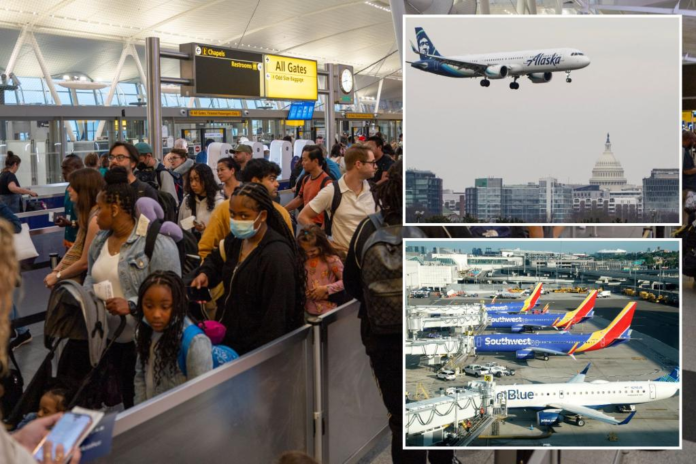The prices for domestic flights have fallen from their recent sky-high levels as demand dwindles — but that’s because travel is surging to international destinations.
Airlines have slashed round-trip flights within the US to a current average of $285, a 15% drop from this time last year, according to online travel booking site Hopper.com’s second-quarter Consumer Travel Index.
The domestic fares are about $50 lower year-over-year and are expected to remain slightly below 2019 levels until the winter holidays when airlines usually boost fares as demand surges.
However, travelers should prepare to experience sticker shock for trips to Europe, which are up 35% from last year, with ticket prices above $1,000.
Round-trip flights to Asia are up 23% from 2022 and an eye-popping 61% higher than it was in 2019, according to Hopper.
“I’m not sure that people have the money, but people have had a shift about how they think about their personal finance,” Ted Jenkin, the CEO and co-founder of oXYGen Financial, which caters to jet-setting pre-millennials, told The Post on Thursday.
“It’s a live-today, worry about retirement tomorrow mindset” since the pandemic, he added.
Waning demand for domestic travel this summer has tanked ticket prices. Hopper.com reported that the average round-trip flight within the US is $285 — a 15% drop from 2022. Christopher Sadowski
People are choosing international destinations over domestic as a form of “revenge travel,” Jenkin added, noting that even from as early as May 2022, travelers still had to show COVID-related documents to get in and out of the US.
However, by the holidays, Jenkin predicts domestic travel will increase and “revenge shopping rates will decline.”
Anton Radchenko, the founder of flight compensation company AirAdvisor, told The Post that many simply can’t afford domestic travel, let alone an international trip, with inflation remaining stubbornly high.
Former airline pilot and University of Nevada, Las Vegas professor Dan Bubb expects airfares to rise on all flights because the price of oil continues to tick higher.
“Airlines are very sensitive to oil prices,” Bubb said, noting prices at the pump have reached an eight-month high.
JetBlue said the appeal of long-haul international flights can be attributed to “a greater-than-expected shift of pent-up COVID demand,” in its Q2 report, which was released on Tuesday.
The airline, which operates in about 100 domestic destinations, slashed its yearly outlook as a result despite a better-than-expected quarterly profit of $138 million, citing a “pressuring demand for domestic travel during the peak summer travel period.”
Personal finance expert Ted Jenkin said Americans are currently splurging on “revenge travel” post-COVID, though that’s likely to wane along with round-trip international flights come the winter holidays. REUTERS
Southwest Airlines — the nation’s largest domestic carrier with 121 US destinations — also reported disappointing second-quarter earnings results, provoking increasing concerns about the strength of domestic travel demand.
The low-cost, Dallas-based airline banked $683 million in net income in Q2, a sharp decline from the $760 million it took home in the same three-month period in 2022.
Alaska Air Group also warned last month that waning domestic demand would hurt financial results — on top of increased fuel expenses and non-fuel operating costs.
As airlines ready themselves to offset the costs of a lackluster summer of domestic travel, many of them are also facing more costly labor contracts.
Just last month, United Airlines and the union representing its pilots reached an agreement on a contract that will raise pilot pay by up to 40% over four years.
The union valued the agreement at about $10 billion, which came following over four years of tumultuous bargaining that included picketing and talk of a strike vote.
Long-haul international flights are booming, which JetBlue attributed to a “pent-up COVID demand.” Getty Images
The deal made United pilot’s employment contracts more competitive with Delta Air Lines which in March approved contracts that included a 34% cumulative pay increase to pilots over three years.
The deal added incremental value to the tune of $7 billion.
After Delta proposed the deal back in December, the Atlanta-based airline’s 15,000 pilots immediately received an 18% pay increase and they can expect a 5% pay bump in 2024 and two 4% pay increases in the two years that follow, according to Delta’s February SEC filing.
American Airlines also followed suit, reaching a tentative agreement in March to add $8 billion in costs with increased pilot pay.
Airlines slash domestic flight prices
Recent Comments
on Army vs. Coastal Carolina live stream, how to watch online, CBS Sports Network channel finder, odds
on AL Rookie of the Year Julio Rodriguez Spreads Joy and Sportsmanship to the Youth of Loma de Cabrera
on After UFC Fallout, Conor McGregor Offers a Valuable Piece of Advice to Free Agent Francis Ngannou
on Dubai International Airport sees 41.6 million passengers in first half of year, more than in 2019
on Devout athletes find strength in their faith. But practicing it and elite sports can pose hurdles
on Despite strong Lunar New Year holiday data, consumer spending in China isn’t roaring back just yet
on Dave Portnoy: Taylor Swift’s security should ‘drag Kim Kardashian to jail’ if she attends Eras Tour
on CONCEPT ART: New Details Revealed for Disney Cruise Line Lookout Cay at Lighthouse Point Destination
on “Completely Knocked Me Out”: Rob Lowe Recalls Boxing Match With Tom Cruise On 1983 Brat Pack Classic
on CBS Sports, Serie A announce new TV rights deal; Paramount+ to air over 400 Italian soccer matches
on Cam Newton’s Violent Public Incident Draws Hilarious Reaction From 3x All-Star: “Where Do I Sign Up
on Boston College vs. Army live stream, how to watch online, CBS Sports Network channel finder, odds
on Angel Reese Launches Foundation Dedicated To Empowering Women Through Sports & Financial Literacy
on A weaker dollar, skyrocketing prices and ‘record’ visitor numbers: Good luck in Europe this summer




